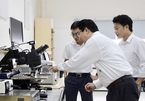 |
| ASEAN pushes forward with 5G connectivty cooperation. Photo: Shutterstock |
It is expected that at the coming 37th ASEAN Summit in Vietnam in November this year, the country and regional member states will discuss solutions to boost the application of 5G regionwide, enabling the bloc to materialise its dream of becoming an e-bloc over the next decade.
5G connectivity is considered part of the Master Plan on ASEAN Connectivity 2025, which is the central node to enhance data management, facilitate harmonisation of data regulations among ASEAN member states, and promote intra-ASEAN data flows.
However, this is largely a self-run programme by member countries, so ASEAN nations will need to maintain discipline to build momentum. The impetus will become more pronounced as 5G begins to be rolled out across Southeast Asia.
Vietnam is now encouraging all member states to speed up their digital transformation in different sectors by interconnecting telecommunications networks.
The ASEAN bloc is now jointly boosting the implementation of some new initiatives that Vietnam advanced two years ago in Hanoi, including a “pan-ASEAN roaming charge for mobile phones” or the “Roam like home” initiative to build a “flat” ASEAN – all these initiatives aim to make roaming charges as cheap as national charges.
In Vietnam, there are four big mobile network operators. Of these, Viettel subscribers can roam to 213 countries and 524 carriers, and Vinaphone can roam to 180 countries and 466 carriers, while MobiFone and Vietnamobile subscribers can also roam to many countries and carriers, according to the Ministry of Information and Communications’ (MIC) Department of International Cooperation.
Viettel already applies uniform charges for all calls, messages, and data among Viettel (Vietnam), Metfone (Cambodia), Unitel (Laos), and Mytel (Myanmar).
“Lowering international mobile roaming charges in ASEAN would surely boost customer demand and would not push users to buy local SIMs or hunt for Wi-Fi. It would go a long way towards promoting flat telecommunications in ASEAN,” said Hoang Minh Hang, representative of the department.
In order to realise the initiative, a consensus of all operators in a country needs to be achieved regarding charges to then begin negotiations between operators in ASEAN member countries.
“Cooperation in digital transformation and digital economy development will be a key topic of discussion at the coming 37th ASEAN Summit in Vietnam later this year,” said an official from the Ministry of Foreign Affairs. “With its great potential in IT and growing digital transformation, Vietnam is learning from other regional nations and also sharing its own experiences to develop into a digital economy and to develop the ASEAN into a big digital economy. This will also help ASEAN address its emerging challenges.”
According to the World Economic Forum, ASEAN is the fastest growing internet market in the world. With 125,000 new users connecting to the internet every day, the ASEAN digital economy is projected to grow significantly, adding an estimated $1 trillion to regional GDP over the next 10 years.
“For all governments, enterprises, and the society, digital transformation is no longer just a choice but a prerequisite for economic and business development,” said MIC Minister Nguyen Manh Hung.
In fact, a similar policy has been applied in the EU since 2017. Same as the ASEAN Economic Community, the EU is a single market characterised by four freedoms of movement: for goods, services, people, and capital.
According to Petri Koistinen, director general of DG Connect at the European Commission, EU operators act as a single actor within the World Trade Organization. The EU’s roaming regulation is an internal market instrument based on Article 114 of the Treaty on the Functioning of the EU.
|
Excerpt from joint statement of the Sixth ASEAN Finance Ministers and Central Bank Governors’ Meeting (October 2, 2020) Financing, payment, and service connectivity We commend the efforts of the Working Committee on Payment and Settlement Systems for the completion of the Implementing Policy Guidelines (IPG) of the ASEAN Payments Policy Framework for Cross-Border Real-Time Retail Payments and the draft guidelines for updating the Annex on Use Cases of the IPG. We were also pleased to note the developments related to cross-border interoperability of standardised QR code for payments and innovative real time remittances, in particular the full implementation of the Singapore-Thailand link, and partial implementation between Laos-Thailand and Cambodia-Thailand links. We also look forward to the live operation of the Singapore-Thailand real-time retail payment system link in 2021. Infrastructure financing We expressed appreciation for the Asian Development Bank’s effort in operationalising the ASEAN Catalytic Green Finance Facility (ACGF) as a platform for ASEAN green infrastructure under the ASEAN Infrastructure Fund by undertaking origination, preparation, and screening of potential green projects. The ACGF is also supported by formidable cofinancing partners with close to $1.5 billion in commitments. We acknowledged the progress of the collaboration on infrastructure financing between the ASEAN Capital Markets Forum (ACMF) and the Working Committee on Capital Market Development. This collaboration focused on developing a set of guiding principles for the standardisation of contractual terms for infrastructure financing that are practical and effective for project documents as well as project finance loan documents to facilitate more private capital financing in the region. VIR |
Huong Thanh

Vietnam takes the lead in ASEAN’s digital evolution
With its great potential in IT, Vietnam as ASEAN chair has been making efforts together with other member states in boosting the application of high technologies to adapt to the Fourth Industrial Revolution, which is sweeping regionwide.

Vietnam to commercialise 5G in October
Vietnam will commercialise 5G network in October using entirely domestically produced equipment, according to the Ministry of Information and Communications (MIC).